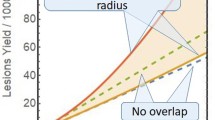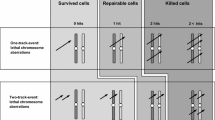Abstract
Ionizing radiation damage to a mammalian genome is modeled using continuous time Markov chains. Models are given for the initial infliction of DNA double strand breaks by radiation and for the enzymatic processing of this initial damage. Damage processing pathways include DNA double strand break repair and chromosome exchanges. Linear, saturable, or inducible repair is considered, competing kinetically with pairwise interactions of the DNA double strand breaks. As endpoints, both chromosome aberrations and the inability of cells to form clones are analyzed. For the post-irradiation behavior, using the discrete time Markov chain embedded at transitions gives the ultimate distribution of damage more simply than does integrating the Kolmogorov forward equations. In a representative special case explicit expressions for the probability distribution of damage at large times are given in the form used for numerical computations and comparisons with experiments on human lymphocytes. A principle of branching ratios, that late assays can only measure appropriate ratios of repair and interaction functions, not the functions themselves, is derived and discussed.
Similar content being viewed by others
References
Albright, N., Tobias, C. A.: Extension of the time-independent repair-misrepair model of cell survival to high LET and multicomponent radiation. In: LeCam, L., Olshen, R. A. (eds.) Proceedings of the Berkeley conference in honor of Jerzy Neyman and Jack Kiefer, pp. 397–424. Belmont CA: Wadsworth 1985
Albright, N.: A Markov formulation of the repair-misrepair model of cell survival. Radiat. Res. 118, 1–20 (1989)
Bedford, J. S., Cornforth, M. N.: Relationship between recovery from sublethal x-ray damage and the rejoining of chromosome breaks in normal human fibroblasts. Radiat. Res. 111, 406–423 (1987)
Bender, M. A., Awa, A. A., Brooks, A. L., Evans, H. J., Groer, P. G., Littlefield, L. G., Pereira, C., Preston, R. J., Wachholz, B. W.: Current status of cytogenetic procedures to detect and quantify previous exposures to radiation. Mutat. Res. 196(2), 59–103 (1988)
Breimann, L.: Probability and stochastic processes. New York: Houghton Mifflin 1969
Brenner, D. J.: Track structure, lesion development, and cell survival. Radiat. Res. 124, S29-S37 (1990)
Charlton, D. E., Nikjoo, H., Humm, J. L.: Calculation of initial yields of single and double strand breaks in cell nuclei from electrons, protons and alpha particles. Int. J. Radiat. Biol. 56(1), 1–19 (1989)
Cornforth, M. N.: Testing the notion of the one-hit exchange. Radiat. Res. 121, 21–27 (1990)
Curtis, S. B.: The lethal and potentially lethal model — a review and recent development. In: Kiefer, J. (ed.) Quantitative mathematical models in radiation biology, pp. 137–146. Berlin Heidelberg New York: Springer 1988
Doraiswamy, L. K., Kulkarni, B. D.: The analysis of chemically reacting systems: a stochastic approach. New York: Gordon and Breach 1987
Erdi, P., Toth, J.: Mathematical models of chemical reactions. Princeton, NJ: Princeton University Press 1989
Frankenberg-Schwager, M.: Review of repair kinetics for DNA damage induced in eukaryotic cells in vitro by ionizing radiation. Radiother Oncol 14, 307–320 (1989)
Friedberg, E. C., Hanawalt, P. C.: Mechanisms and consequences of DNA damage processing. New York: Alan R. Liss 1988
Goodhead, D. T.: Relationship of microdosimetric techniques to applications in biological systems. In: Kase, K., Bjarngard, B., Attix, F. (eds.) The Dosimetry of ionizing radiation, vol. II, pp. 1–89. Orlando, FA: Academic Press 1985
Hagen, U.: Biochemical aspects of radiation biology. Experientia 45(1), 7–12 (1989)
Hahnfeldt, P.: Markov models of radiation damage. Thesis, MIT, 1991
Hlatky, L., Sachs, R. K., Hahnfeldt, P.: Reaction kinetics for the development of radiation-induced chromosome aberrations. Int. J. Radiat. Biol. 59(5), 1147–1172 (1991)
Hou, Z., Guo, Q.: Homogeneous denumerable Markov processes. Berlin: Springer and Beijing: Science Press 1988
Hug, O., Kellerer, M.: Stochastik der Strahlenwirkung. Berlin Heidelberg New York: Springer 1966
Iliakis, G.: Radiation-induced potentially lethal damage: DNA lesions susceptible to fixation. Int. J. Radiat. Biol. 53(4), 541–584 (1988)
Kellerer, A. M.: Fundamentals of microdosimetry. In: Kase, K., Bjarngard, B., Attix, F. (eds.) The dosimetry of ionizing radiation, pp. 78–162. Orlando, FA: Academic Press 1985
Lea, D. E., Catcheside, D. G.: The mechanism of induction by radiation of chromosome aberrations in Tradescantia. J. Genet. 44, 216–245 (1942)
Lea, D. E.: Actions of radiations on living cells, second edition. Cambridge: Cambridge University Press 1955
Lloyd, D. C., Edwards, A. A., Prosser, J. S., Barjaktarovic, N., Brown, J. K., Horvat, D., Ismail, S. R., Koteles, G. J., Almassy, Z., Krepinsky, A.: A collaborative exercise on cytogenetic dosimetry for simulated whole and partial body accidental irradiation. Mutat. Res. 179(2), 197–208 (1987)
McQuarrie, D. A.: Stochastic approach to chemical kinetics. J. Appl. Probab. 4, 413–478 (1967)
Obaturov, G. M., Mateeva, L. A., Tyatte, E. G., Yas'kova, E. K. The stochastic model of formation of chromosome aberrations and radiation inactivation of cells (in Russian). Radiobiol. 20, 803–809 (1980)
Radford, I. R.: The dose-response for low-LET radiation-induced DNA double-strand breakage: methods of measurement and implications for radiation action models. Int. J. Radiat. Biol. 54(1), 1–11 (1988)
Reddy, N. M. S., Mayer, P. J., Lange, C. S.: The saturated repair kinetics of Chinese hamster V79 cells suggests a damage accumulation-interaction model of cell killing. Radiat. Res. 121, 304–311 (1990)
Revell, S. H.: Relationships between chromosome damage and cell death. In: Ishihara, T., Sasaki, M. S. (eds.) Radiation-induced chromosome damage in man, pp. 215–233. New York: Alan R. Liss 1983
Sachs, R. K., Hlatky, L.: Stochastic dose-rates in radiation cell survival models. Rad. Environ. Biophys. 29, 169–184 (1990)
Sachs, R. K., Hlatky, L., Hahnfeldt, P., Chen, P-L.: Incorporating dose rate effects in Markov radiation cell-survival models. Radiat. Res. 124, 216–226 (1990)
Sachs, R. K., Chen, P-L., Hahnfeldt, P., Lai, D., Hlatky, L.: DNA damage in non-proliferating cells subjected to ionizing radiation at various dose rates. (In preparation, 1991)
Savage, J. R. K.: The production of chromosomal structural changes by radiation: an update of Lea (1946), Chapter VI. Br. J. Radiol. 62(738), 507–520 (1989)
Shadley, J. D., Afzal, V., Wolff, S.: Characterization of the adaptive response to ionizing radiation induced by low doses of X rays to human lymphocytes. Radiat. Res. 111(3), 511–517 (1987)
Tobias, C. A., Blakely, E. A., Ngo, F. Q. H., Yang, T. C. Y.: The repair-misrepair model of cell survival. In: Meyn, R. E., Withers, H. R. (eds.) Radiation biology in Cancer Research, pp. 195–229. New York: Raven 1980
Virsik, R. P., Harder, D.: Recovery kinetics of radiation-induced chromosome aberrations in human G 0 lymphocytes. Radiat. Environ. Biophys. 18, 221–228 (1980)
Wallace, S., Painter, R.: Ionizing radiation damage to DNA: molecular aspects. J. Cell. Biochem. Supplement 14A, 21–84 (1990)
Ward, J. F.: DNA damage produced by ionizing radiation in mammalian cells: identities, mechanisms of formation, and repairability. In: Cohn, W., Moldave, K. (eds.) Prog. Nucleic Acid Res. Mol. Biol., vol. 35, pp. 95–125. New York: Academic Press 1988
Ward, J. F.: The yield of DNA double strand breaks produced intracellularly by ionizing radiation: a review. Int. J. Radiat. Biol. 57(6), 1141–1150 (1990)
Weber, K. J.: Models of cellular radiation action — an overview. In: Kiefer, J. (ed.) Quantitative mathematical models in radiation biology, pp. 3–28. Berlin Heidelberg New York: Springer 1988
Wolff, R. W.: Stochastic modeling and the theory of queues. Englewood Cliffs, NJ: Prentice Hall 1989
Yang, G. L., Swenberg, C. E.: Stochastic models for cells exposed to ionizing radiation. In: Eisenberg, J., Witten, M. (eds) Modelling of Biomedical Systems, pp. 85–89. Amsterdam New York: Elsevier 1986
Author information
Authors and Affiliations
Additional information
This work was supported in # DMS-9025103
Rights and permissions
About this article
Cite this article
Hahnfeldt, P., Sachse, R.K. & Hlatky, L.R. Evolution of DNA damage in irradiated cells. J. Math. Biol. 30, 493–511 (1992). https://doi.org/10.1007/BF00160533
Received:
Revised:
Issue Date:
DOI: https://doi.org/10.1007/BF00160533




